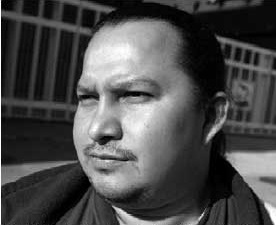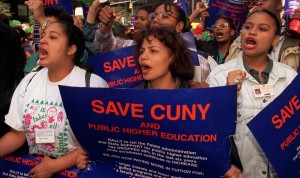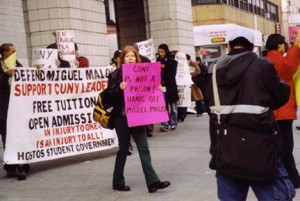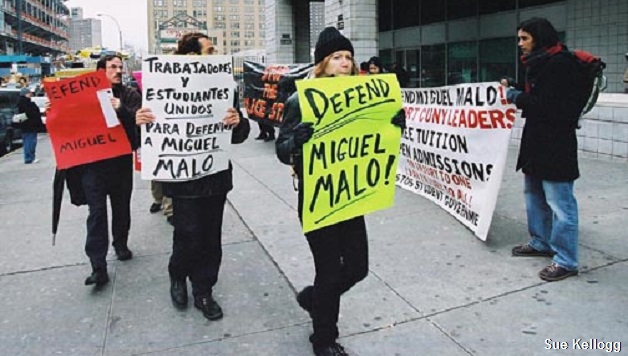Standing Up to Intimidation

As Miguel Malo stood near the college registration line on August 15, 2001 and held up a sign in Spanish, a squad of armed paramilitary campus security officers jumped him and threw him to the ground. The sign was knocked out of his hands, and he was cuffed and dragged to the security office. There, he was videotaped and booked. Repeatedly he asked for his cuffs to be loosened, to stop the digging into his flesh, but his requests were ignored.
As vice-president of the student government at Hostos Community College and an Ecuadorian immigrant, Miguel felt responsible to organize the student body against big cuts to bilingual studies programs and increases in registration fees. These budget cuts meant that many poor immigrant students would be barred from getting a college education. Miguel reasoned that if an immigrant can be pushed down to the ground and arrested for holding a sign, then someone needed to push back.
Plead Out or Bleed Out
Miguel was charged with attacking two security guards and resisting arrest. Since Miguel’s arrest, the prosecution piled on more charges as a means of intimidation. Instead, Miguel was determined to fight even harder to prove his innocence.
Miguel was offered a plea bargain, but the CUNY authorities insisted that the deal include an apology to the police officers who beat him. Miguel, a 35-year-old father of two, refused the agreement and went forward to trial at great risk to himself and his family. In the post 9/11 political climate, the charge of physically attacking a security guard holds the possibility of a year’s jail sentence and deportation. Still, Miguel Malo refused to be afraid.
Frame-Up Trial
Four years later, after prosecutorial delays, scores of court appearances, three lawyers and one mistrial, Miguel’s court case finally began in September 2005. The Assistant District attorney, Terry Gensler, painted a picture of Miguel as an ungrateful immigrant troublemaker, who derived pleasure from disrupting public order just for kicks. The prosecution’s inconceivable story was that Miguel was creating disorder with his one man protest and when arrested, a handcuffed five feet one inch tall Miguel, had dragged two muscular security guards, each six feet tall, down a corridor and injured both officers as he threw himself against a wall. Gensler told the jury that Miguel’s goal was to create chaos and anarchy “by any means necessary.”
Judge Catherine Bartlett aided the prosecution’s charade by barring faculty members from testifying to the gentleness and decency of Miguel’s character and from giving testimony as to the legality of Miguel’s behavior in an area traditionally designated for free speech. Nonetheless, a number of student witnesses corroborated Miguel’s assertion that eight to ten armed SAFE team paramilitaries came out of hiding as soon as he raised his sign, separated him from the students on the registration line, pushed him to the ground, kneed him in the back, and dragged him rapidly away to the security office.
Twelve Drowsy Men
Miguel’s jury was overwhelmingly middle aged, verging on elderly, apparently of African-American and Latino ethnicity and solidly working class. Yet, contrary to the image of the legal system portrayed on television and in the theater, not all jurors are attentive and absorbed by the cases before them. One of the jurors tried desperately to get thrown off the jury by inventing a loud cough; when the judge denied this excuse, the cough promptly disappeared. Needless to say, this juror had a disinterested air throughout the rest of the proceedings. Two other jurors slept throughout the trial, at moments breaking into loud snores.
It is impossible to say what goes on behind the walls of the jury room, but Miguel’s conviction pointed to the fact that after September 11, it is sufficient to invoke the fear of chaos and disorder to convict someone without proof or credible motive. And so it happened that an innocent man was convicted, and the two security guards, the real criminals, went free.
A Free Academy
The management of CUNY (City University of New York) was becoming increasingly preoccupied with blocking student protest. CUNY had been a tuition-free university since its founding as the Free Academy in 1848. Tuition was introduced in 1974, triggering a wave of student unrest. The task of the administration was to follow the dictates of big business and take back all the major gains of the student movements of the 60’s and 70’s. As open admission, college preparation classes, bilingual studies, and Black and Latino history departments were continually attacked, CUNY officials pursued massive tuition increases.

In spite of these onslaughts, when former Democratic Governor Mario Cuomo proposed $90 million dollars of CUNY budget cuts in 1991, the student response was deafening. Tens of thousands of high school and CUNY students took over the streets as the NYPD in riot gear batoned and pepper sprayed the crowd. This wave of student radicalism was repeated throughout the Nineties. At one point during a demonstration in 1995, students defended themselves from a police onslaught and one ripped the shield off a police helmet as a female high school student held aloft a book by Bobby Seals declaring “These are the books we need to read.” A number of CUNY campuses were occupied for over two weeks, and, to the chagrin of the politicians and the school administrators, no expulsions and only one suspension resulted.
Revolution and Counter Revolution
Deplorably, the student/administration skirmishes throughout the past decade were not accompanied by any significant political challenge to the corporate agenda of the Republican and Democratic politicians. Since CUNY had been free for 150 years, the rallying cry for student activists was that CUNY should be free again, a demand which directly clashed with the policies of both the Republican and Democratic parties and showed the need for a radical political challenge by workers and young people to the capitalist political establishment.
Unfortunately, the labor leaders who were invited on to the platforms of the student demonstrations of the 90’s like Dennis Rivera of Local 1199/SEIU, discouraged all talk of independent political action for the working class. This absence of a working class political alternative created a vacuum, which was filled by semi-anarchist grouplets, growing like mushrooms in a cave. These groups provided no real leadership to the movement, and by the beginning of 2000, they no longer functioned.
Instead of educating the new layer that was coming onto the campuses, many of the student leaders of the 90’s who formed the SLAM groups (Student Labor Action Movement), or the direct action groups like Love and Rage went on to parlay their activism for jobs in academia or to become junior level labor bureaucrats.

(Photo: Sue Kellogg)
For the student movement to have the strongest impact and mobilize the widest public support, the student’s demands needed to be linked to broader social and working class issues: such as the need for free, quality education, combined with a full program of jobs, education, health care and housing. To fundamentally change the structure of education and to win jobs, healthcare, etc, a political alternative to the two parties of big business is needed – a mass party for working people and youth. Unfortunately, in the struggle of the CUNY students an opportunity to advance independent working class politics was lost.
The student movement was blind-sided by the CUNY bureaucracy counter-attack. Forbearance for student political protest met its limits. It was inevitable that the power structure would wait for its opportunity to strike against the students. And strike hard they did.
Lock and Load
Using the Freedom of Information Act, a student journalist, Keith Higginbotham, uncovered that CUNY purchased 110,000 rounds of ammunition, 4,000 rounds of 9 mm hollow point bullets, 390 rounds of shotgun ammo, 9 glock automatic pistols with night sights, 400 mace and pepper spray dispensers, hundreds of extending batons, body armor and riot helmets. An armed paramilitary force had been created. The Orwellian “SAFE Team” security force had stockpiled one bullet for every two CUNY students.
Surveillance Not Safety
There was no justification for this paramilitary force. Crime rates at CUNY campuses are among the lowest in the country and levels of crime have been constant for over a decade even after armed squads patrolled the campuses. Then why does CUNY have the most extensive security apparatus of any campus university, public or private in the United States?
The real reason for the armed goons on CUNY campuses becomes clearer if we examine how they are used. The first five of six times the SAFE team was used, student protest was the reason. In this period, the armed paramilitary SAFE team began to monitor student protests and drew up a student “enemies” list to bar student activists from campus events. A 1995 memo from Captain McDermott confirmed the prime purpose of the SAFE team was to squash campus protest. SAFE officers even installed a video camera and conducted surveillance of the student club offices on a CUNY campus.
Bullets or Books?
Four years later, after prosecutorial delays, scores of court appearances, three lawyers and one mistrial, Miguel’s court case finally began in September 2005. The Assistant District attorney, Terry Gensler, painted a picture of Miguel as an ungrateful immigrant troublemaker, who derived pleasure from disrupting public order just for kicks. The prosecution’s inconceivable story was that Miguel was creating disorder with his one man protest and when arrested, a handcuffed five feet one inch tall Miguel, had dragged two muscular security guards, each six feet tall, down a corridor and injured both officers as he threw himself against a wall. Gensler told the jury that Miguel’s goal was to create chaos and anarchy “by any means necessary.”
Judge Catherine Bartlett aided the prosecution’s charade by barring faculty members from testifying to the gentleness and decency of Miguel’s character and from giving testimony as to the legality of Miguel’s behavior in an area traditionally designated for free speech. Nonetheless, a number of student witnesses corroborated Miguel’s assertion that eight to ten armed SAFE team paramilitaries came out of hiding as soon as he raised his sign, separated him from the students on the registration line, pushed him to the ground, kneed him in the back, and dragged him rapidly away to the security office.
Frame-Up Trial
In 1995, while 173 CUNY faculty were fired because of “budget cuts”, CUNY hired 577 civil service police officers, 148 entry level security assistants, and 250 contract security guards.
CUNY nearly doubled its security funding from $21.8 million to $40 million dollars. CUNY’s armed camp posture was unprecedented, since neither SUNY (State University of New York) nor private schools allowed guards to use guns on campus. Faculty resolutions were passed calling for complete disarming of CUNY security. Yet the teachers’ resolutions for demilitarization were ignored.
Biting the Hand… Anti-War Student Demonstrators Greet Colin Powell
Student activism was a tradition at CUNY. From Vietnam to the war in Iraq, the student movement has connected the war abroad with the war against living standards at home. In 1990, large protests broke out when General Colin Powell, a City College alumnus, and one of the key architects of the invasion of Panama, came back to accept an honorary degree. This was a major embarrassment for the CUNY officialdom.
Interestingly, a great majority of the attacks against student anti-war demonstrations at CUNY campuses can be traced to the City College Campus. City College (a CUNY campus located in Harlem) receives large endowments to its science and engineering departments from the Pentagon and the military industrial complex. The CUNY board of directors is obviously more concerned for the well-being of its military paymasters than the First Amendment.
Carol Lang’s Arrest and the Case of the City College Four
Carol Lang, a political activist and an employee of City College since the 70’s was one of a handful who peacefully protested the military recruiters at a campus job fair in March, 2005. Immediately campus security forced the protesters into a corridor and started to beat them. Two of the students were treated in the hospital for a contusion to the jaw and a concussion respectively. Carol Lang tried to stop the arrest of one of the students who was photographing the event and was detained by the guards.
Then a frame up pattern similar to Miguel Malo’s case revealed itself. Two days after the protest, Carol was arrested at her desk by two campus security guards who maintained that she had attacked them. As a result she was booked and detained by the police for 30 hours.
The charges against the students and Carol Lang were later dropped. The students accepted an ACD (Adjournment in Contemplation of Dismissal) which is a sort of a plea bargain, in that the arrested party does not maintain their innocence, nor are they allowed to speak about the terms of the adjournment and they must “keep their noses clean” for a set period of time, usually six months. This is usually quite effective as a deterrent to further political activity.
Carol Lang, a worker, was treated more harshly. Even though criminal charges were also dropped against her, she was docked four weeks of pay, and when she went to an arbitration hearing to protest this judgment, a judge demanded that an additional five weeks pay be docked. Since she went through a period of involuntary suspension, her union, DC 37 further victimized her by depriving her of a contractual bonus; saying that she was not in good standing at the time the bonuses were due to be paid out.
Students are Guilty Until Proven Innocent
Immediately after the students arrest, City College President Williams decreed none of them should be allowed back on campus, even before a hearing or trial was conducted. Just as in Miguel’s case, the college president made statements assuming that the students were guilty without any evidence other than the trumped up testimony of the security guards.
The Importance of Miguel’s Stand

CUNY repression against student activism has always been strongest in CUNY campuses embedded in poverty stricken communities and in communities of color, such as City College in Harlem or at Hostos Community College in the South Bronx (the poorest congressional district in the United States). The ruling class clearly fears student activism from the poorest layers of US society, such as immigrants, working class, and people of color.
Miguel Malo’s trial was the last remnant of the CUNY student activism of the 90’s. It was viewed as a cutting edge case. Student activism at CUNY has seen a sharp decline in the past decade as shown by the lukewarm student response to CUNY’s recent proposal for automatic annual tuition increases of 11%. This has not created more than a blip of activity on the campuses.
Even though protests against the war in Iraq have rattled the CUNY administration to the point that they have been compelled to frame up small groups of people like Miguel and Carol Lang, the administration has not had to respond to anywhere near the level of activism of the last three decades.
Therefore, the vindictiveness of the CUNY administration and their willing lackeys in the Bronx District Attorney’s office is thrown into relief by their eagerness in dragging the father of two small children with no prior criminal record and a reputation for honesty and community service through the courts for four years.
The Bronx DA – Misdemeanors Are Us
One of the most powerful political figures in the Bronx, District Attorney Robert Johnson, sat in on the trial, at one point in the back row in full view of the judge and the jury. This was an unmistakable signal to rookie Judge Bartlett, who had only three cases in her judicial career, and not one of them until now in the Bronx. Johnson was saying loud and clear “Throw this one to me.”
This was made even clearer when the prosecution requested setting bail at $3,000. They never spoke to the defense about bail, contrary to the common practice of the court. Bail is unheard-of for a misdemeanor connected with a campus protest. The judge reduced it to $500, forcing Miguel’s supporters to scramble to raise the money and keep him out of jail.
Miguel’s case sure was getting a lot of attention for a little old misdemeanor. Miguel was getting the “treatment”- all because he wouldn’t show fear and bow down to their power.
The CUNY bigwigs certainly didn’t want any student protests against tuition hikes, the war in Iraq, or military recruiters on campus. Rather, their dream was to turn CUNY into an elitist institution rather than the means for working class, poor, immigrant, and students of color to acquire a college education.
The Role of Socialist Alternative
Socialist Alternative understood the ramifications of Miguel’s case and began to play a key role at an early stage. A number of our members, in addition to other political activists, formed the nucleus of Miguel’s hard-core support. We organized demonstrations and press conferences outside the courthouse, holding placards in English and Spanish such as “Miguel Malo is innocent! Drop the charges now,” “CUNY is not a prison – Free Miguel Malo.”
The court officers and bailiffs were shocked as we packed the courtroom for Miguel’s 50 court appearances. In addition to CUNY supporters, five elderly African-American men and women in a group called CourtWatch sat in on the trial proceedings. We sent a clear message from the start: Don’t mess with Miguel!
Our members conducted a media campaign through faxes, e-mails and phone calls which enabled many big business newspapers like the New York Times, Spanish language papers, and radio and television stations to cover the press conferences and the demonstrations of the Miguel Malo defense campaign, over the course of the four year ordeal.
The fact that the key organizers of Miguel’s defense were socialists, helped immensely. We had no trust in the courts of the ruling class, and we knew that Miguel would be saved primarily by the pressure that the CUNY community and the working class exerted on the legal proceedings. Aside from the courthouse demonstrations and community speak-outs in support of Miguel, the campaign collected over 1,600 signatures on Free Miguel petitions as well as over 60 letters from faculty members and even campus clergy who supported Miguel and asked for no jail time to be assigned.
Thou Shalt Not Use Rosa Parks’ Name in Vain
The night that Miguel was convicted, word came through the press that the civil rights icon, Rosa Parks had died. The next morning, outside Hostos Community College, Miguel’s supporters held a press conference in the rain to protest the verdict.
In front of the TV cameras we exposed the hypocrisy of the big business politicians who where falling over themselves to pay homage to Rosa Parks’s act of civil disobedience, but were content to jail a hardworking immigrant because he held up a sign in protest. We need to expose the hypocrisy of the big business politicians who talk about the “brave” acts of Rosa Parks yet are perfectly happy to sentence an immigrant who fights for the rights of the poorest in this society to prison and deportation.
“I’m Leaning Towards Incarceration”
Judge Bartlett sternly lectured Miguel for nearly 20 minutes at his sentencing. She pointed out (incorrectly) that historical victories like equal rights for women and African-Americans were accomplished only through non-violence. “I’m leaning toward incarceration, Mr. Malo, but in light of the support you have received from the community, I will sentence you to 10 days of community service and three years probation.”
The sentence was a bittersweet victory for the defense campaign because even though Miguel was framed up and convicted of a crime he did not commit, both the District Attorney’s office and the CUNY administration used all their power and authority to jail Miguel and failed to achieve their ultimate goal.
The Lessons Learned
The experience of the campaign was invaluable for the members of Socialist Alternative. We were able to gain respect and experience through our consistent struggle to free this student activist. We have been invited to participate in a monthly radio program about CUNY activism, and will undoubtedly deepen our roots in the CUNY student movement for the movements to come.


